Some of you may be wondering, but we've deliberately avoided defining "Wakamon" as we enter the fourth installment of this column. The reason is that we at Dentsu Inc. Wakamon Project believe "real life can't be seen through generation or gender alone." That said, when it comes to financial situations, high school and college students differ in both their allowances and disposable income (obviously!). This time, we'll focus on high school and college students.
High school students receive an average allowance of ¥7,586, with the largest group receiving "¥3,000 to ¥5,000." College students receive an average of ¥22,753, with the largest group receiving "¥10,000 to ¥30,000." Interestingly, even compared to data from five years ago, there hasn't been a significant change.

*Source: Dentsu Inc. "Heisei Student Survey 2012" (conducted September 2012, targeting 700 male and female students aged 15-22 in Tokyo and six prefectures)
However, the common sense among young people is that 'cheap goods and good service are a given, and information should be free and high-quality'. Within their limited allowances, the desire to 'avoid making bad purchases' is evident in various buying behaviors.
Data shows over half agree with statements like "I appreciate pre-selected shopping options" and "I tend to buy what I consider the 'right choice' in that category." They prefer shopping where they meticulously check multiple layers of information—referencing friends or online reviews to sift through vast amounts of data and products—and verify right before buying that the purchase won't be a dud for them.
One reason lies in their upbringing. They were born and raised amidst major economic crises: the 1991 bubble burst, the 2001 dot-com crash, and the 2008 Lehman Shock.
The prolonged effects of deflation made low prices the norm; various goods and services became flat-rate, virtually eliminating open-ended pricing. Meanwhile, the widespread adoption of PCs and mobile phones as universally accessible tools profoundly changed their lives. Needless to say, over 90% of high school students owned mobile phones, and around 90% used social networking sites, making them nearly ubiquitous. By September 2012, over 40% of high school students had already switched to smartphones. Everyone gained access to vast amounts of information anytime, and various things became available "cheaply," "quickly," and "easily."

*Based on a Dentsu Inc. original survey conducted in September 2012
In other words, when it comes to their limited allowance, they take the preliminary steps of deciding "how to allocate it," "where to spend it," and "whether that purchase is the right choice." Even after buying something, they verify "whether that purchase was the right choice." Essentially, the cultivation of a mindset of "not wanting to make mistakes" or "not wanting to miss out," combined with increased accessibility to information, has likely become the factors driving this "shopping PDCA cycle*1" among today's young people.
Observing young people today may reveal glimpses of a new tomorrow or signs of new change.
*1 Repeating the four stages: Plan → Do → Check → Act
We've launched the Facebook page for the 'Youth Research Department (Dentsu Inc. Wakamon)'!
http://www.facebook.com/wakamon.dentsu




